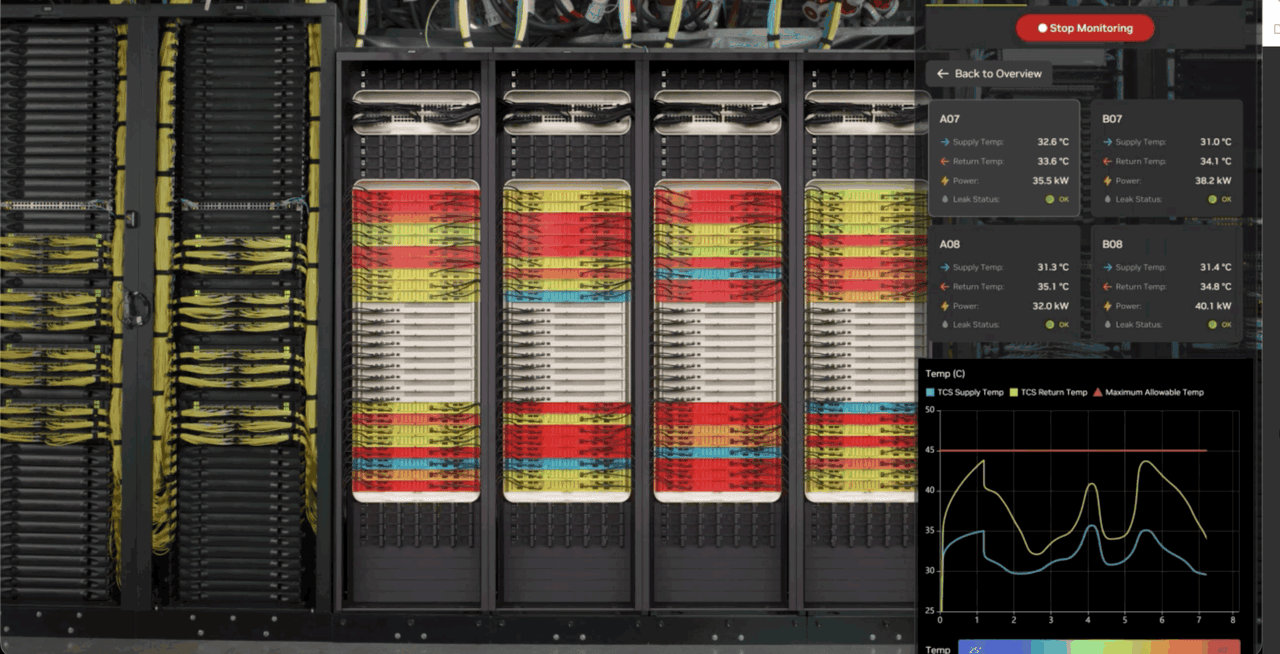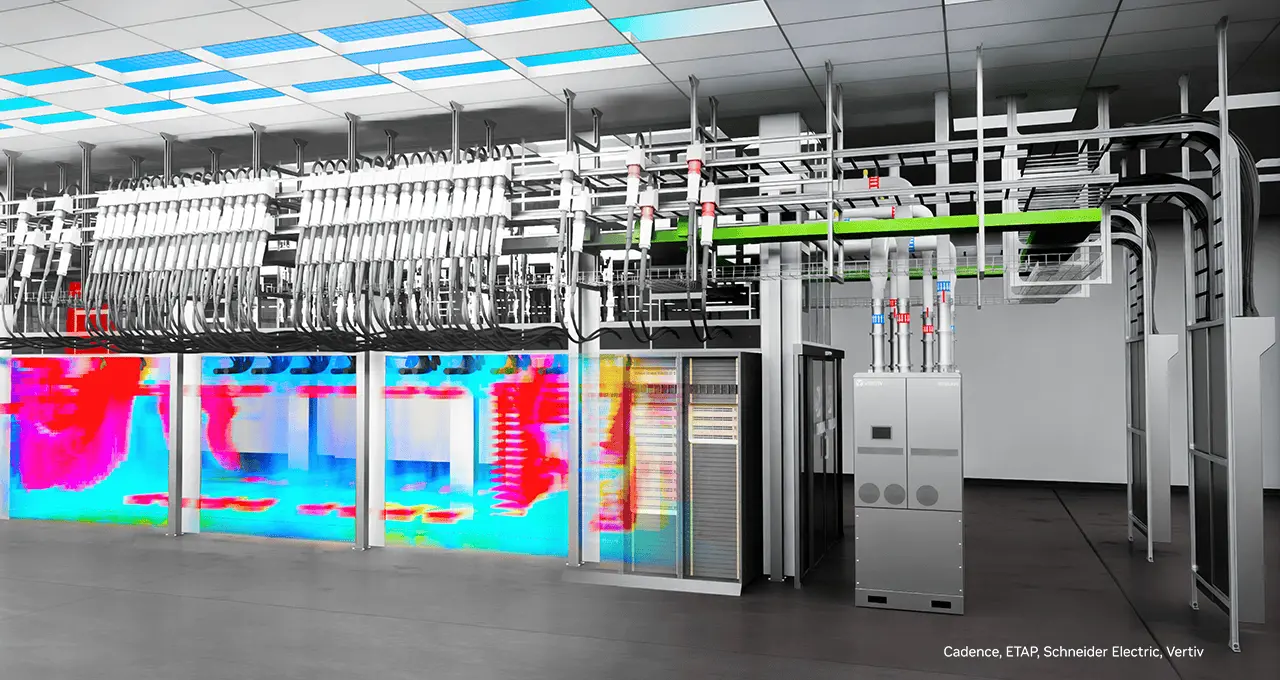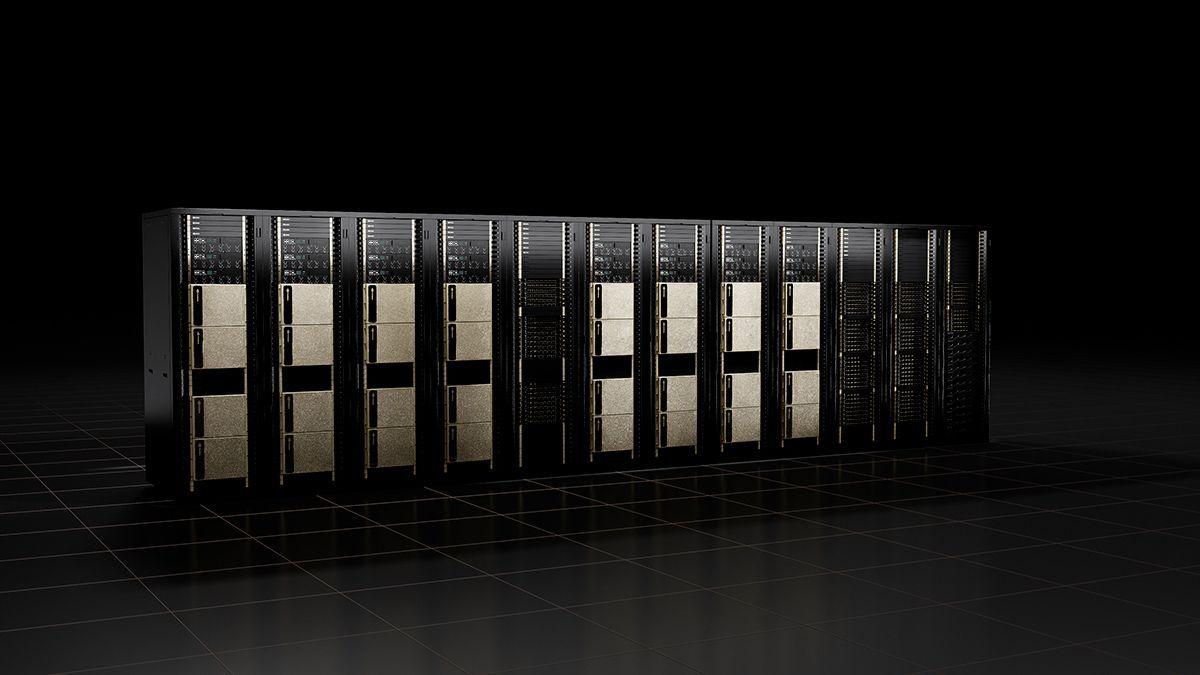Nvidia Unveils Omniverse DSX Blueprint for Gigawatt-Scale AI Data Centers
4 Sources
4 Sources
[1]
Nvidia announces reference design for gargantuan gigawatt-scale Omniverse DSX data centers -- single data center requires a nuclear reactor's worth of power generation
Nvidia used to be a humble supplier of graphics processors, providing reference designs for its partners' graphics cards. As the company grew, it moved from data center-grade GPUs for AI and HPC to reference designs for servers, then to rack-scale solutions. At its GTC 2025 summit, the company announced Omniverse DSX Blueprint: a reference design for gigawatt-class AI data centers, or what Nvidia calls AI factories. The Omniverse DSX is Nvidia's blueprint for gigawatt-scale data centers, purpose-built for training and running large AI models, which was designed and simulated using the company's Omniverse framework. The blueprint combines digital-twin simulation in Omniverse with real-world engineering data to create a unified environment where partners can plan, build, and optimize every aspect of an AI data center -- from power and cooling systems to compute and networking layouts. In practice, DSX acts as a reference design and software-driven control layer for data centers ranging from 100 MW to multi-GW capacity. It was validated at Nvidia's AI Factory Research Center in Manassas, Virginia, and underpins real deployments, including the 2 GW Switch site in Georgia and the 1.2 GW Stargate facility in Abilene, Texas. To make its DSX reference design more adaptable for different data centers, it has two configurational frameworks, DSX Boost and DSX Flex: The Omniverse DSX reference design for a gigawatt-class data center is meant to enable new players to build AI factories from scratch using hardware from Nvidia and its partners, without much experience in building such facilities, which have unique requirements. For such companies, DSX Blueprint will help maintain compatibility across processors, networking, and cooling systems, and align energy requirements with minimal redesign effort. To that end, expect the DSX blueprint to accommodate not only the current Blackwell generation of hardware, but also future product generations, including Vera Rubin, though not in the first version. While Nvidia offers some flexibility with DSX blueprints (as it does with graphics cards), customers are meant to adhere to the reference design as closely as possible. "Blueprints are reference designs," said Kari Briski, vice president of generative AI software for enterprise at Nvidia. "So, they are meant to be a reference of what we think is the best performance, software put together to achieve a use case. So, of course you can choose and replace as you feel necessary. But we have what we do with the blueprints as we test them end to end, we run performance and QA on them to ensure that all the components and APIs work together."
[2]
Nvidia's AI factory dream gets the Omniverse treatment
GPU giant teams with partners to create digital twin blueprint for next-gen datacenters Nvidia unveiled Omniverse DSX at its GTC event in Washington DC -- a blueprint for designing and operating gigawatt-scale AI datacenters using digital twin technology. The GPU giant also confirmed the build-out of an AI Factory Research Center at Digital Realty's Manassas, Virginia site to develop the platform, which combines Nvidia's Omniverse simulation environment with open source Universal Scene Description (OpenUSD) technology. "Nvidia started out by designing chips, and then we started to design systems, and we designed AI supercomputers. Now we're designing entire AI factories," said CEO Jensen Huang during his GTC keynote. The platform creates a digital twin of the physical datacenter, including building, power, and cooling infrastructure that acts as an operating system once the facility goes live. Nvidia claims this enables continuous optimization for performance, energy efficiency, and sustainability. Datacenter infrastructure provider Schneider Electric is partnering on the project, having announced its own Omniverse-based digital twin platform at GTC in March. Huang has repeatedly positioned these GPU-dense facilities as distinct from traditional datacenters. "It's an AI factory because this factory produces one thing," he said on stage. "It runs AI. And its purpose is designed to produce tokens that are as valuable as possible, meaning they have to be smart. And you want to produce these tokens at incredible rates because when you ask an AI for something, you would like it to respond." "This AI factory is what we're building for Vera Rubin, and we created a technology that makes it possible for all of our partners to integrate into this factory digitally," he added. Huang previously claimed that AI factories will become "the bedrock of modern economies" around the world. Nvidia also unveiled BlueField-4 at GTC, its next-genetation data processing unit (DPU) for accelerating infrastructure operations inside AI datacenters. Essentially designed to offload network and storage functions, BlueField-4 combines a Grace CPU featuring 64 Arm Neoverse V2 cores with ConnectX-9 networking and supporting Ethernet and InfiniBand at up to 800 Gbps per port. It claims the DPU has 6x the compute power of BlueField-3. The new silicon is purpose-built as an end-to-end engine for a new class of AI storage platform, serving as the foundation of high-performance data pipelines for AI factories. Early availability of BlueField-4 is expected to come with the launch of the Vera Rubin platform in 2026. ®
[3]
NVIDIA Launches Omniverse DSX Blueprint, Enabling Global AI Infrastructure Ecosystem to Build Gigawatt-Scale AI Factories
Your browser doesn't support HTML5 video. Here is a link to the video instead. During the GTC Washington, D.C., keynote today, NVIDIA founder and CEO Jensen Huang introduced NVIDIA Omniverse DSX, a comprehensive, open blueprint for designing and operating gigawatt-scale AI factories -- validated at the new AI Factory Research Center at Digital Realty's site in Manassas, Virginia. The blueprint brings together ecosystem partners across the industry that are tapping into NVIDIA Omniverse libraries and OpenUSD to set a new standard for building and operating gigascale AI factories. For the first time, the building, power and cooling can be codesigned with NVIDIA's AI Infrastructure stack -- and the process of the Virginia research center build out is captured as a scalable, repeatable recipe validated in a real-world deployment. OpenUSD and SimReady Asset Adoption Accelerate the Design Process It starts with the digital twin, where engineering and construction partner Jacobs can design the building, then optimize compute density and overall layout to maximize token throughput according to power constraints. Jacobs engineers aggregate SimReady OpenUSD assets for power, electrical and cooling equipment from partners including Siemens, Schneider Electric, Trane and Vertiv into PTC's product lifecycle management system -- allowing cross-functional teams to collaborate in real time on photorealistic 3D models, accelerate design decisions and reduce development risk with shared, version-controlled product data. The advancement of SimReady assets from hardware partners and growing adoption of OpenUSD across industries plays a crucial role in the acceleration of building out these highly complex designs. The Cadence Reality Digital Twin platform has been purpose-built on top of the blueprint, with integrated Omniverse libraries and accelerated by NVIDIA CUDA. This allows engineers to simulate thermals and electricals in a high-fidelity, physically accurate 3D environment to test designs, predict failures and optimize operations in the digital twin before construction. Physical Build-Out and Operations Optimized With Digital Twins Once the AI factory has been designed virtually, NVIDIA partners like Bechtel and Vertiv deliver prefabricated modules that are factory built, tested and ready to plug in. This significantly reduces build time and allows for modular scalability, helping achieve faster time to revenue. The architecture of the DSX blueprint means once the physical AI factory comes online, the digital twin can be used as an operating system to monitor, inspect and further optimize processes. For example, AI agents from partners including Phaidra and Emerald AI are trained in the digital twin, and then allow engineers to prompt and optimize power consumption to reduce strain on both the AI factory and the power grid. Phaidra AI agents continuously optimize power, cooling and workloads, turning the AI factory digital twins into a self-learning system that boosts grid flexibility, resiliency and energy efficiency. Emerald AI integrates its reference design in DSX to enable utilities to unlock underutilized grid capacity. What DSX Delivers DSX maximizes GPU productivity and energy efficiency across the compute fabric with a single digital twin environment that can be simulated, optimized and used for operations. Prefabricated modules from infrastructure partners prove how AI factories can be designed, assembled, validated and expanded with speed and consistency. Three Pillars of DSX: * DSX Flex - Dynamic Grid Collaboration: Balances energy demand with real-time grid conditions using Omniverse telemetry and AI agents, improving efficiency and grid cooperation to help tap some of the 100 gigawatts of underutilized grid capacity. * DSX Boost - Performance-Per-Watt Optimization: Applies NVIDIA's power-optimization technologies at the data center level, running workloads at Max-Q efficiency -- the point of optimal performance per watt -- for up to 30% higher GPU throughput within the same power envelope. * DSX Exchange - Unified IT/OT Integration: Acts as the secure data and control fabric linking operational systems for power, cooling and safety with NVIDIA's software stack and Omniverse digital twins through real-time application programming interfaces and partner integrations. Why It Matters * Scalability: Common architecture for AI factories from 100 megawatts to multi-gigawatts. * Efficiency: DSX Boost maximizes token throughput per megawatt. * Sustainability: DSX Flex enables renewable generation and adaptive grid balance. * Integration: DSX Exchange unifies digital twins, facility systems and operations. Together with energy and equipment specialists -- Eaton, GE Vernova, Hitachi, Schneider Electric, Siemens Energy, Trane and Vertiv -- DSX combines expertise in power, cooling and grid interaction to deliver resilient, efficient operations optimized for the NVIDIA Grace Blackwell and Vera Rubin platforms. This ecosystem extends beyond hardware, to software and AI solution providers, with Cadence, Emerald AI, Phaidra, PTC, Schneider Electric ETAP, Siemens and Switch collaborating to build agentic digital twin solutions. Their adoption of OpenUSD and Omniverse libraries help to power dynamic simulation, autonomous control and end-to-end optimization for every stage of the AI factory lifecycle. Designed to scale to multi-gigawatt capacity, DSX accelerates design cycles and validates infrastructure before deployment. Watch the Omiverse DSX demo and read the full press release to learn more about how NVIDIA is shaping the era of gigascale AI factories. Learn more about how NVIDIA and partners are advancing AI innovation in the U.S. by watching the NVIDIA GTC Washington, D.C., keynote by Huang. See notice regarding software product information.
[4]
Vertiv Unveils Gigawatt-Scale Reference Architectures for NVIDIA Omniverse DSX Blueprint
"The AI industrial revolution requires a complete reinvention of data center infrastructure. Vertiv's collaboration with NVIDIA is foundational to our mission of equipping our customers with the most advanced and flexible solutions to navigate this transformation," said Scott Armul, executive vice president global portfolio and business units at Vertiv. "The Vertiv reference architecture for NVIDIA Omniverse DSX is more than just a blueprint; it's a holistic approach that accelerates the deployment of AI at a scale previously unimaginable. Through our comprehensive grid-to-chip solutions and flexible deployment models like the Vertiv™ OneCore platform, combined with the power of digital twins within the NVIDIA Omniverse libraries, we are enabling the factories of the future, today." The Vertiv reference architectures feature several key innovations: · Optimized Power Topologies: Vertiv's innovative "Grid-to-Chip" power train is engineered to improve upon the NVIDIA Omniverse DSX Blueprint, resulting in a system that is more efficient and occupies a smaller physical footprint. This approach provides the resilience and scalability needed for multi-generational AI platforms. · Advanced Liquid Cooling Solutions: The architecture integrates Vertiv's industry-leading liquid cooling systems, designed to manage the extreme thermal demands of accelerated computing. This advanced thermal solution, combined with a complete chip-to-heat reuse thermal chain, enables a closely matched design for advanced performance for current and future compute generations. · Deployment Flexibility: Recognizing that every AI deployment is unique, the Vertiv reference architecture is the first to offer a validated design for stick-built, hybrid, and prefabricated deployment methodologies. This flexibility can reduce Time to First Token by up to 50% compared to traditional construction builds, allowing organizations to choose the best path for their specific goals.
Share
Share
Copy Link
Nvidia announces a comprehensive blueprint for designing and operating massive AI data centers requiring nuclear reactor-level power. The Omniverse DSX combines digital twin technology with real-world engineering to create gigawatt-scale AI factories.
Nvidia's Ambitious Vision for AI Infrastructure
Nvidia has unveiled its most ambitious infrastructure project yet: the Omniverse DSX Blueprint, a comprehensive reference design for building and operating gigawatt-scale AI data centers. Announced at the company's GTC 2025 summit in Washington D.C., this blueprint represents Nvidia's evolution from a graphics processor supplier to an architect of entire AI ecosystems
1
.
Source: DT
"Nvidia started out by designing chips, and then we started to design systems, and we designed AI supercomputers. Now we're designing entire AI factories," said CEO Jensen Huang during his keynote address
2
. These facilities, which Huang positions as distinct from traditional data centers, are purpose-built for one primary function: producing AI tokens at unprecedented rates and intelligence levels.Digital Twin Technology at the Core
The Omniverse DSX Blueprint leverages digital twin technology, combining Nvidia's Omniverse simulation environment with open source Universal Scene Description (OpenUSD) technology
2
. This approach creates a unified digital environment where partners can plan, build, and optimize every aspect of an AI data center, from power and cooling systems to compute and networking layouts1
.
Source: NVIDIA
The blueprint has been validated at Nvidia's AI Factory Research Center in Manassas, Virginia, built in partnership with Digital Realty
3
. This facility serves as a real-world testing ground for the DSX concepts and underpins actual deployments, including the 2 GW Switch site in Georgia and the 1.2 GW Stargate facility in Abilene, Texas1
.Three-Pillar Architecture
The DSX blueprint operates on three fundamental pillars designed to maximize efficiency and scalability
3
:DSX Flex focuses on dynamic grid collaboration, balancing energy demand with real-time grid conditions using Omniverse telemetry and AI agents. This system aims to improve efficiency and grid cooperation while tapping into approximately 100 gigawatts of underutilized grid capacity.
DSX Boost applies performance-per-watt optimization at the data center level, running workloads at Max-Q efficiency—the optimal performance per watt ratio. This approach can deliver up to 30% higher GPU throughput within the same power envelope.
DSX Exchange serves as the unified IT/OT integration layer, acting as a secure data and control fabric that links operational systems for power, cooling, and safety with Nvidia's software stack and Omniverse digital twins through real-time APIs and partner integrations.

Source: The Register
Related Stories
Industry Partnership Ecosystem
The blueprint brings together an extensive ecosystem of industry partners. Engineering and construction partner Jacobs handles building design and optimization, while companies like Siemens, Schneider Electric, Trane, and Vertiv provide SimReady OpenUSD assets for power, electrical, and cooling equipment
3
.Vertiv has developed specific reference architectures featuring optimized power topologies through their "Grid-to-Chip" power train, advanced liquid cooling solutions, and flexible deployment methodologies that can reduce Time to First Token by up to 50% compared to traditional construction
4
.The Cadence Reality Digital Twin platform, built on top of the blueprint with integrated Omniverse libraries and CUDA acceleration, allows engineers to simulate thermals and electricals in high-fidelity 3D environments
3
.References
Summarized by
Navi
[2]
Related Stories
NVIDIA Expands Omniverse Platform to Revolutionize AI Factory Design and Industrial Robotics
19 Mar 2025•Technology

NVIDIA Expands Omniverse Blueprint for AI Factory Digital Twins, Accelerating Industrial AI Development
19 May 2025•Technology

NVIDIA Unveils 800V High-Voltage DC Power System for Next-Gen AI Data Centers
28 May 2025•Technology

Recent Highlights
1
AI Chatbots Sway Voters More Effectively Than Traditional Political Ads, New Studies Reveal
Science and Research

2
OpenAI declares code red as Google's Gemini 3 gains 200 million users in three months
Technology

3
Trump approves Nvidia H200 chip exports to China with 25% revenue cut, defying Senate concerns
Policy and Regulation





